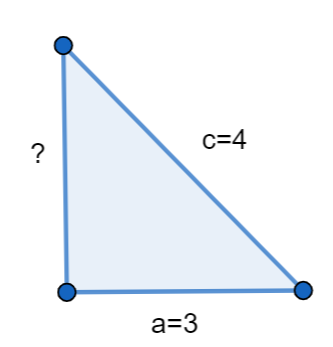
How do you use the Pythagorean Theorem to find the missing side of the right triangle with the given measures given c is the hypotenuse and we have a = 3, c = 4?
Answer
525.6k+ views
Hint: In this problem we have to use the Pythagorean Theorem to find the missing side of the right triangle with the given measures given c is the hypotenuse and we have a = 3, c = 4. We know that the Pythagoras Theorem is \[{{a}^{2}}+{{b}^{2}}={{c}^{2}}\]. We can see that, we are already given the value for a and c, which we can substitute in the formula where the missing side is b, which we have to find.
Complete step-by-step answer:
We know that we have used the Pythagorean Theorem to find the missing side of the right triangle with the given measures given c is the hypotenuse and we have a = 3, c = 4.

We know that the Pythagoras Theorem is \[{{a}^{2}}+{{b}^{2}}={{c}^{2}}\].
We can substitute the value a = 3, c = 4 in the above formula, we get
\[\Rightarrow {{3}^{2}}+{{b}^{2}}={{4}^{2}}\]
We can now simplify the above step, we get
\[\begin{align}
& \Rightarrow {{b}^{2}}=16-9 \\
& \Rightarrow {{b}^{2}}=7 \\
\end{align}\]
We can now take square root on both sides, we get
\[\Rightarrow b=\sqrt{7}\]
Therefore, the missing side of the given right triangle is \[\sqrt{7}\]units.

Note: Students should remember the Pythagoras theorem formula is \[{{a}^{2}}+{{b}^{2}}={{c}^{2}}\]. Where the sum of squares of two sides is equal to the square of the hypotenuse. We should also see that the given triangle should be a right angle triangle, where Pythagoras theorem is only applied to right-angled triangles. We can also consider a as the perpendicular and find b as the base as it will lead to the same answer.
Complete step-by-step answer:
We know that we have used the Pythagorean Theorem to find the missing side of the right triangle with the given measures given c is the hypotenuse and we have a = 3, c = 4.

We know that the Pythagoras Theorem is \[{{a}^{2}}+{{b}^{2}}={{c}^{2}}\].
We can substitute the value a = 3, c = 4 in the above formula, we get
\[\Rightarrow {{3}^{2}}+{{b}^{2}}={{4}^{2}}\]
We can now simplify the above step, we get
\[\begin{align}
& \Rightarrow {{b}^{2}}=16-9 \\
& \Rightarrow {{b}^{2}}=7 \\
\end{align}\]
We can now take square root on both sides, we get
\[\Rightarrow b=\sqrt{7}\]
Therefore, the missing side of the given right triangle is \[\sqrt{7}\]units.

Note: Students should remember the Pythagoras theorem formula is \[{{a}^{2}}+{{b}^{2}}={{c}^{2}}\]. Where the sum of squares of two sides is equal to the square of the hypotenuse. We should also see that the given triangle should be a right angle triangle, where Pythagoras theorem is only applied to right-angled triangles. We can also consider a as the perpendicular and find b as the base as it will lead to the same answer.
Recently Updated Pages
Master Class 12 Business Studies: Engaging Questions & Answers for Success

Master Class 12 Economics: Engaging Questions & Answers for Success

Master Class 12 English: Engaging Questions & Answers for Success

Master Class 12 Maths: Engaging Questions & Answers for Success

Master Class 12 Social Science: Engaging Questions & Answers for Success

Master Class 12 Chemistry: Engaging Questions & Answers for Success

Trending doubts
Which places in India experience sunrise first and class 9 social science CBSE

Fill the blanks with the suitable prepositions 1 The class 9 english CBSE

Write the 6 fundamental rights of India and explain in detail

Difference Between Plant Cell and Animal Cell

What is pollution? How many types of pollution? Define it

What is the full form of pH?




